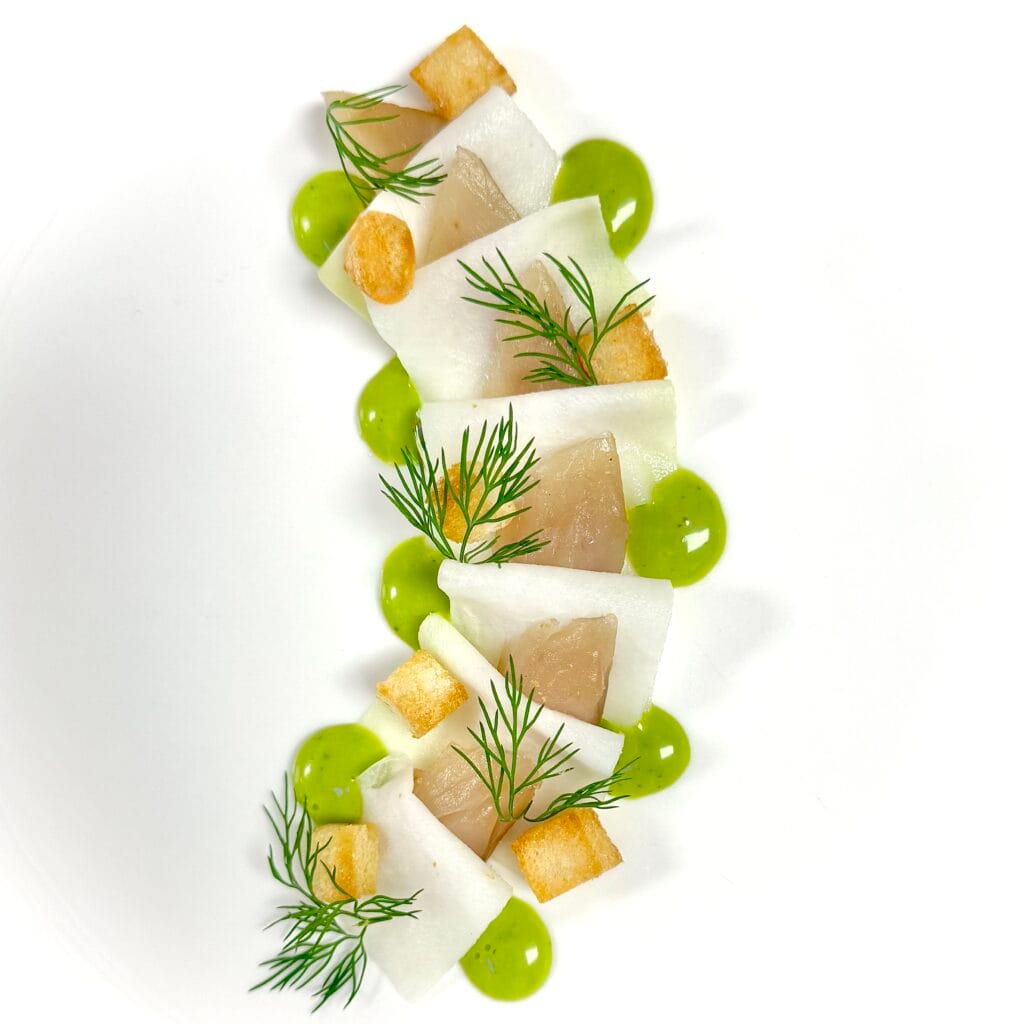
This refreshing cold starter features delicate marinated mackerel paired with crisp kohlrabi slices, creating a perfect balance of flavours and textures. The vibrant dill emulsion adds a burst of herbal freshness, while crunchy croutons finish the dish with a satisfying bite. A light and elegant way to start any meal, showcasing the best of seasonal, fresh ingredients.
ingredients
For the mackerel
- 1 fresh mackerel
- 100g smoked maldon salt
- 1 lime zest
- 1 lemon zest
- 1 orange zest
- bread croutons
- dill garnish
For the kohlrabi
- 1 kohlrabi
- 250ml water
- 250ml white wine vinegar
- 250ml sugar
for the dill emulsion
- 2 egg yolks
- 5g dijon mustard
- 200ml dill oil
- 10ml sherry vinegar
- salt
for the dill oil
- 200ml neutral oil ( e.g. sunflower, grapeseed)
- 150g dill
instructions
For the mackerel
Begin by filleting the mackerel with care, making sure to remove all the bones. Gently peel off the skin, trying to keep the fillets whole and clean.
In a bowl, mix a generous amount of smoked maldon salt with the freshly grated zest of lemon, lime, and orange. This aromatic blend will both season and lightly cure the fish.
Place the fillets in a shallow dish and cover them completely with the citrus salt mixture. Let them cure in the refrigerator for about 20 minutes. This step helps to firm up the texture while infusing the fish with bright, fresh flavours.
Once cured, rinse the fillets quickly under cold running water to remove any excess salt and zest. Pat them dry gently with paper towels. The mackerel is now ready to be sliced.
For the kohlrabi
Trim and peel the kohlrabi, then cut it into a large rectangular block to create even slices. Using a mandoline, slice it as thinly as possible to ensure a delicate texture and uniform shape.
In a saucepan, combine water, sugar, and vinegar. Bring the mixture to a boil and let it simmer for 10 minutes. This will create a lightly sweet and tangy pickling liquid.
Remove the pan from the heat and allow the liquid to cool completely to room temperature. This step is important to avoid over-softening the kohlrabi.
Once the liquid has cooled, submerge the thin kohlrabi slices in it. Let them marinate for about 15 minutes to absorb the flavour while retaining their crispness.
for the dill oil
Blanch the dill: Bring a small pot of water to a boil. Quickly blanch the dill for 10–15 seconds, then immediately transfer it to a bowl of ice water to stop the cooking and preserve its vibrant green colour.
Dry the dill: Once cooled, drain the dill thoroughly and pat it completely dry using a clean kitchen towel or paper towels. Excess moisture can affect the oil’s texture and shelf life.
Blend: Place the blanched and dried dill into a blender along with the neutral oil. Blend on high speed for 1–2 minutes until the mixture is smooth and bright green.
Strain: Pour the oil through a fine mesh sieve or a piece of muslin/cheesecloth into a clean container. Avoid pressing the solids too much to keep the oil clear.
For the dill emulsion
Proceed with the recipe for a normal mayonnaise, but use green dill oil instead of the normal one.
To plate the dish, alternate layers of the marinated mackerel and thin slices of kohlrabi. Drizzle the dill emulsion generously.
Finish the dish with homemade croutons for a crunchy contrast. If the bread you’re using for the croutons is too soft, place it in the freezer until it becomes firm. Then, slice it and toast the slices in the oven at 170°C (340°F) until they develop a beautiful golden colour and crispy texture.